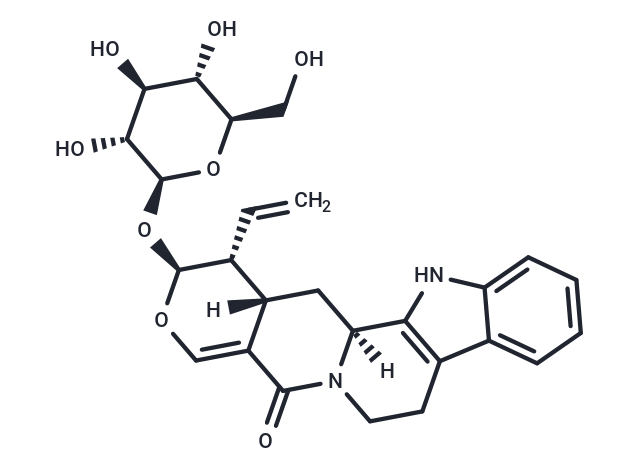Shopping Cart
- Remove All
 Your shopping cart is currently empty
Your shopping cart is currently empty

Strictosamide possesses antibacterial and antiviral activities, it also may have important effects on inflammation and inflammatory pain.

| Pack Size | Price | Availability | Quantity |
|---|---|---|---|
| 1 mg | $57 | In Stock | |
| 5 mg | $128 | In Stock | |
| 10 mg | $190 | In Stock | |
| 25 mg | $318 | In Stock | |
| 50 mg | $469 | In Stock | |
| 100 mg | $689 | In Stock | |
| 1 mL x 10 mM (in DMSO) | $140 | In Stock |
| Description | Strictosamide possesses antibacterial and antiviral activities, it also may have important effects on inflammation and inflammatory pain. |
| In vitro | At 20 and 40 mg/kg, strictosamide obviously decreased the TPA-induced mice ear edema (24.7 and 28.1% inhibition, respectively), and significantly inhibited acetic acid-stimulated peritoneal vascular permeability in mice (23.3 and 33.4% inhibition, respectively).?It also significantly decreased the leukocytes in the mice peritoneal cavity induced by CMC-Na at all the tested doses (46.0, 49.1, and 58.7% inhibition, respectively).?To acetic acid-induced writhing test in mice, strictosamide markedly prolonged the pain latency at 20 and 40 mg/kg and decreased the writhing counts at 40 mg/kg (49.7% inhibition).?However, it did not obviously improve the pain threshold of mice in hot-plate test[2]. |
| Molecular Weight | 498.52 |
| Formula | C26H30N2O8 |
| Cas No. | 23141-25-5 |
| Smiles | [H][C@@]12C[C@]3([H])N(CCc4c3[nH]c3ccccc43)C(=O)C1=CO[C@@H](O[C@@H]1O[C@H](CO)[C@@H](O)[C@H](O)[C@H]1O)[C@@H]2C=C |
| Relative Density. | 1.53 g/cm3 (Predicted) |
| Storage | Powder: -20°C for 3 years | In solvent: -80°C for 1 year | Shipping with blue ice. | |||||||||||||||||||||||||
| Solubility Information | DMSO: 22.5 mg/mL (45.13 mM) | |||||||||||||||||||||||||
Solution Preparation Table | ||||||||||||||||||||||||||
DMSO
| ||||||||||||||||||||||||||

Copyright © 2015-2024 TargetMol Chemicals Inc. All Rights Reserved.